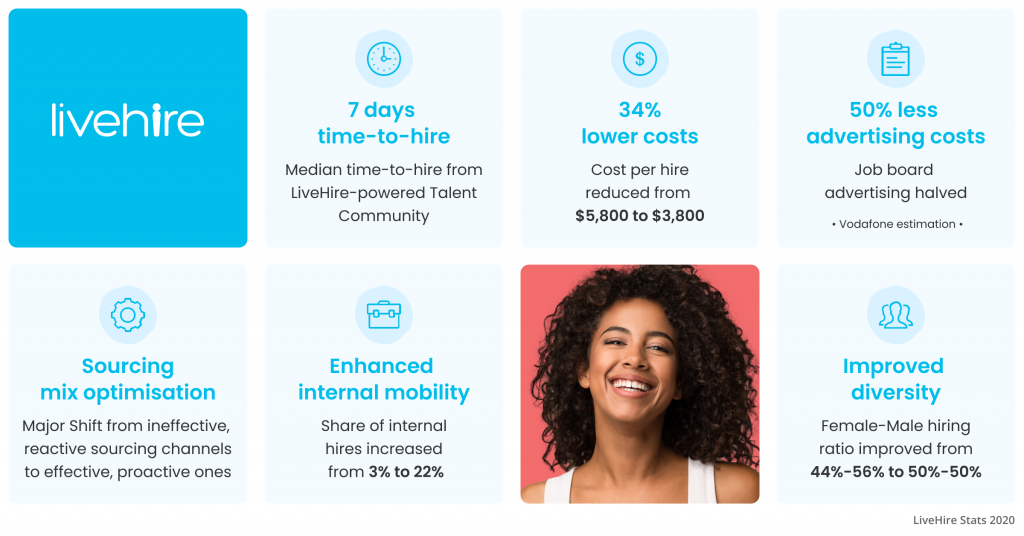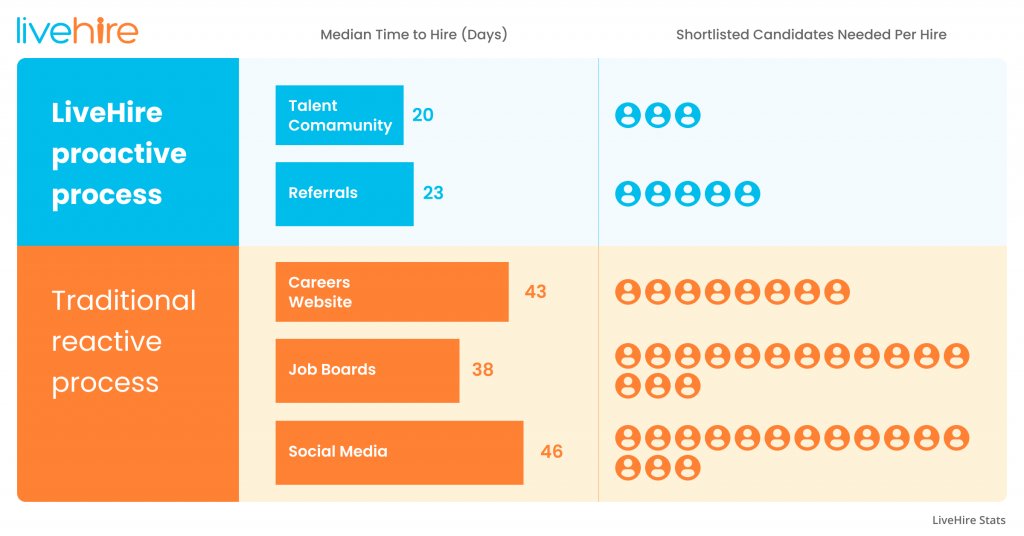
Creating a seamless recruitment process can be difficult. It can become overwhelming, with so many technologies and different ways of working. Learn how to break down the recruitment process to develop a better way of working with a great candidate experience.
Fixing a Broken Recruitment Process
Many recruitment processes are outdated and aren’t delivering cost efficiency or consumer-grade candidate experiences.
Imagine a world where organizations have optimized their recruitment process. Candidates, recruiters, hiring managers and agencies all seamlessly work together to fill vacancies. Technology automates unwieldy (but often necessary) processes and integrates with other technologies (with no manual workarounds). Candidates and recruiters enjoy mutually satisfying relationships, and hiring managers fill gaps in their teams quickly and with high quality employees. External recruitment agencies are managed centrally by the human resource team. Finally, the employer brand is an experience delivered through each touch point, and candidates gain insight into what it’s really like to be an employee before they enter the organization.
If all this sounds utopian, then let us take you on a journey about how our clients have achieved all this with ease and stunning results.
Roadblocks to Hiring Efficiency Success
- Macro Economic Challenges
- Organization Challenges
- Candidate Expectations and Behavior
Today’s modern organizations and HR teams say that attracting and developing talent is core to their organizational success. Surely it’s as simple as finding, developing and retaining people who in turn help deliver business outcomes? As modern HR teams know, multiple roadblocks make this straightforward process, inherently challenging. These are grouped below:
Macro Economic Challenges:
COVID-19 disruption, international instability, economic downturn.
Organizational Challenges:
Slimmed down recruitment teams, outdated recruitment processes and legacy hiring technologies.
Candidate Expectations and Behavior:
Candidates with consumer-esque standards, not enough candidates in high demand roles (e.g. technology) but an oversupply in other roles.
While HR can’t change the macro-economic environment, HR can control the two other facets: (i) reviewing recruitment processes and swapping in modern technology, and (ii) deepening their understanding of candidate expectations (and delivering these via their Employer Value Proposition throughout the hiring journey).
What are the stages to a better recruitment process?
The following is a guide for savvy HR and Recruitment teams who want to optimise their hiring processes.
- Break up with your Legacy Applicant Tracking System (ATS)
- Put your Candidate’s Experience First
- Choose your Metrics Wisely
- Focus on Proactive Recruitment Channels
- Create Talent Pools to Crush Your Hiring Metrics
- Enhance Gender Diversity
- Centralise Agency Management with One Platform
1. Break up with your Legacy Applicant Tracking System (ATS)
Vodafone Australia, a client of LiveHire, did exactly this. HR Director, Vanessa Hicks, had a firm commitment to people: “Employees are the secret to the sustainability of our business. We are committed to attract and hire the best talent, and invest in each individual to maximize their potential”.
The roadblock to this commitment, however, was Vodafone’s small recruitment team’s legacy Applicant Tracking System (ATS) that created inefficiencies across the entire hiring process. By replacing it with LiveHire’s modern recruitment software, Vodafone established the foundation for an exceptional recruitment experience.
The heart of this transformation saw Vodafone eliminate manual processes and optimize hiring team collaboration. LiveHire’s all-in-one recruitment marketing and applicant tracking solution allowed Vodafone’s hiring team to source, engage and hire well-fitted candidates from a single platform.
Significant benefits that Vodafone enjoy only 6 months post-LiveHire implementation include:
2. Put your Candidates’ Experience first
A study by PWC in 2019 said that nearly half (49%) of job seekers say they’ve turned down an offer because of a bad candidate experience. Further to this, PWC said that today’s candidates expect a technology-led, human centred hiring process, coupled with instant communication.
A key step in delivering great experiences is to analyze the underlying process and remove barriers that lead to bad experiences and add features that create great experiences. What is daunting for HR is that even if they wanted to remove barriers and engineer great candidate experiences, it simply isn’t possible using legacy recruitment technologies.
Modern platforms, like LiveHire, actually enable slimmed-down hiring teams to remove negative experience barriers and deliver outstanding experiences. It does this by empowering recruiters with: a real-time, 360 view of each candidate from a variety of recruitment source channels, smart search engine capability to locate the perfect candidate, AI powered intelligent job matching, and most importantly, a unique 2-way text message communication capability; we challenge you to find any other ATS which can do all of these!
And instant communication is a real competitive advantage, especially in a candidate short market. A recent 2021 study by Zety showed that 42% of recruiters said that slow response times to calls and emails was a key barrier to hiring. But this barrier is no more. The results of text communications are impressive – LiveHire has a 17 minute average median response time to two-way SMS texts between recruiters and candidates. Finally recruiters can communicate with instant, personal, and relevant candidate information in a way that feels modern, and just like how we talk to friends today.
oOh!media, a client of LiveHire, did just this. They had a commitment to manage all candidates, regardless of hiring outcome, in an engaging manner and expand their employer brand. By optimizing their hiring process to create candidate-centric ‘memorable moments that matter’ they aligned their process to their employer brand and established the foundation for an award winning candidate experience. oOh!media were the winners of the prestigious CandE Awards (Candidate Experience) in 2018. People & Culture Consultant, Sophie Burgess, said “…Of all the ATS systems I’ve used over the years, LiveHire balances the user experience with strong functionality and a humanistic approach to hiring.”
Progressive HR teams know that to deliver a great experience and fast hiring outcomes, they need to remove barriers. Leveraging technology, like LiveHire, is a very straightforward way to do this.
3. Choose your Metrics Wisely (and your goals wildly)
(i) Deliver Faster Time-to-Hire and Time-to-Fill
What is Time-to-Hire?
Time-to-hire (TTH) is one of the most high impact and visible metrics measuring the success of talent acquisition teams and candidate experience. TTH can be defined as the time between the date a candidate is sourced or applies, and the date they accept and sign the job offer.
What is Time-to-Fill?
Time-to-Fill (TTF) measures the amount of time between the application date or source, and the date the candidate starts (i.e. it’s inclusive of the time between signing a contract and the actual candidate start date).
Why Measure Time-to-Hire and Time-to-Fill?
The longer the TTH, the more disenfranchised candidates become and the more negative their experiences are. Often timing is exacerbated by a lapse in communication with the recruiter or hiring manager. This contributes to candidates feeling unimportant and undervalued – not a great outcome if you are competing in a candidate short market or if you are seeking to promote a positive employer brand.
High TTF has an impact on organizational productivity and success. When a vacancy occurs, pressure is acutely felt by both hiring managers – who juggle multiple workloads and gaps – and recruiters – who have to source talent quickly in a candidate short market. The longer hiring managers carry additional workloads, the less productive the organization becomes.
HR and recruiters can deliver on lofty goals for TTH and TTF which were previously impossible with old technology. But with the right recruitment technology and hiring approach (more on this below) this suddenly becomes achievable.
(ii) Reduce Cost-Per-Hire
‘Do more with less’. This statement is now a modern organizational mantra but is especially true in a post-COVID world. Most organizations are looking to save money, and recruitment spend on agencies and job boards is an easy target. According to Gartner, cost-per-hire is often used to measure the efficiency of a recruiting function, saying that “an increasing cost-per-hire is usually indicative of inefficiencies”.
A recent report by LinkedIn shows that the average Australian company spends 39% of their recruitment budget on job boards/advertising and 28% of their budget on recruitment agencies. Over-reliance on job boards and agencies can become very costly and therefore, can lead to cost inefficiency. LiveHire clients like Vodafone and KJR have reduced their spend on agencies by 29% and 78% respectively, and managed to reduce their time-to-fill and deliver a better candidate experience. KJR even won the CandE (candidate experience) awards in 2019 after improving their hiring efficiency. The question is how? Keep reading to learn more about how to do this with the power of Tlouds.
(iii) Drive quality with Shortlist-to-Hire metrics
There is a common belief that ‘more is always better.’ But when it comes to candidate shortlists, the goal is quality, not quantity. To deliver an optimized, proactive hiring function, a key efficiency metric for TA leaders is shortlist-to-hire conversion rates.
The activity of short listing candidates from hundreds of resumes is a challenging and time-consuming step in the recruitment process. Shortlist-to-hire conversion is determined by looking at each source channel and calculating the average number of shortlisted candidates required to make one successful hire. The lower the ratio (for example 3 short listed candidates for every 1 hire), the more efficient the recruitment process. The higher the ratio (for example 20 candidates for every 1 hire made), the more inefficient the recruitment process. The inefficiencies are twofold: more candidates means (i) more time recruiters take to engage and screen applications, and (ii) more time hiring managers take away from their jobs to interview.
At LiveHire, our clients’ shortlist-to-hire ratios are low. That’s because we guide recruiters to create their own organizational Talent Cloud and manage high demand or strategic roles with Talent Pools. LiveHire data shows that for each role filled from the Talent Cloud channel, the hiring manager will only need to review 3 shortlisted candidates to find a good match. This is therefore a very efficient channel.
LiveHire client data shows that for roles filled via external job boards or social networks, managers will need to review an average of 15 shortlisted candidates, before they find one they want to offer. This is therefore a more inefficient channel.
So why is there such a difference? A Talent Pool is a proactive approach which fills talent pipelines with engaged, pre-qualified, and well-fitted candidates that not only match the role criteria, but are also aligned with an organization’s purpose, culture and values. It means fewer potential candidates but a higher level of quality. It’s a low-pressure recruitment process that enables candidates to experience the company culture and values, and allows recruiters to have meaningful career conversations. Recruiters feel safe in the knowledge that they can present three of their best candidates and predict that the hiring manager will happily choose one. It answers the question “so what is it really like to work here?” and of course this happens to deliver an outstanding candidate experience.
Keep reading below for what recruitment processes HR should implement to deliver on each metric.
4. Focus on Proactive Recruitment Channels
Much like generating sales and marketing leads, the key to a successful TA sourcing strategy is optimising the hiring channel mix. A hiring channel is the route that you choose when you are looking for the ideal way to locate the best candidates in the places they frequent most. At LiveHire, we often think about channels in two main categories: Passive and Proactive.
What are Passive Channels in Recruitment:
Job Boards, Careers Websites and Social Media Networks. These channels can be very effective for developing brand awareness and they have been the dominant strategy used by recruitment teams to date.
What are Proactive Channels in Recruitment:
Talent Clouds/Talent Pools, Referrals and Internal Hiring. At LiveHire, we find that focusing more attention on these channels delivers faster time-to-hire, improves candidate quality, and reduces cost-per-hire.
What are the Best Source Channels to Use for Recruitment?
For the most part, the average HR function won’t have enough time or budget to hire through every channel and deliver a great experience. The answer to this is for HR to focus on choosing the most efficient channel source mix (we recommend clients focus on proactive channels) and aligning their metrics like time-to-hire and cost-per-hire. These two simple actions will improve overall hiring efficiency and effectiveness.
5. Create Talent Pools to crush your Hiring Metrics
Traditional recruitment processes start when the hiring manager has a vacancy and needs to hire someone into a specific role. At that point, recruiters try to source well-matched candidates, by sifting through the mountain of potential candidates that are coming through job boards, activating passive candidates that may or may not be interested – or paying hefty recruitment agency fees.
LiveHire’s proactive approach is to use Talent Pools to simplify this recruitment process. Talent Pools allow recruiters to start building their talent pipelines before the hiring need arises. Recruiters are no longer beholden to a particular job board. Instead, they invite talent to join their organization’s Talent Cloud using their LiveHire-powered career site, Google, Facebook, or LinkedIn. Recruiters create role-specific Talent Pools leveraging Artificial Intelligence to identify the well-fitted pool of candidates and send them targeted, personalised communications via text message and email.
The results? This approach significantly reduced time-to-hire. For example, using LiveHire’s Talent Cloud approach Vodafone only needs 7 days to hire well-fitted employees. It’s more efficient for recruiters and creates a consumer-grade candidate experience.
The strategic use of Talent Pools highlights the power of recruiters building a warm pool of engaged talent before the hiring need arises. And this is the secret to how slimmed-down hiring teams are delivering high quality hires, at speed, while reducing cost-per-hire.
Client Story: Read more about how Vodafone optimised their hiring function
6. Enhance gender diversity
According to the Workplace Gender Equality Agency (WGEA) “Workplace gender equality is achieved when people are able to access and enjoy the same rewards, resources and opportunities regardless of gender.”
Conscious and unconscious bias can occur during any recruitment process. Fortunately, we have seen significantly progress on this issue across our client base. We’re proud to report that the LiveHire platform is helping companies achieve 15% better diversity outcomes than the industry standard.
Data gathered from the LiveHire platform shows that gender biases are not common once a candidate begins to advance through the recruitment process. The biggest challenge, rather, occurs at the start of the recruitment process where unintended barriers still exist. According to WGEA, “multiple studies have demonstrated that when women apply for jobs, they receive fewer interview invitations than equally qualified men” and “face tougher evaluation of their credentials during the initial recruitment stage.” Additionally, studies have shown that women are less likely to apply for a role unless they believe they can fulfill all the advertised criteria.
LiveHire helps solve this barrier in two ways. Firstly, proactive Talent Cloud invitations invite candidates to express interest and engage with an organization before a vacancy arises. At that moment, candidates can find out about the organization first, rather than judging whether they are qualified to do a certain role – a real boost for women. Secondly, LiveHire’s Artificial Intelligence (AI) capability supports the screening process and tagging of candidates across multiple Talent Pool streams, based on the skills and experiences of the candidates, irrespective of gender.
By reducing these two barriers to entry, women feel confident to engage with organizations and recruiters are supported by technology which suggests (in an unbiased way) well-fitted candidates across multiple roles. This in turn creates a virtuous hiring cycle for women.
7. Centralise Agency Management with one platform
Centralising communication, management and cost of recruitment agencies in one place is available with LiveHire. A constant source of frustration for HR and Talent Acquisition is hiring managers bringing unsolicited candidate resumes from recruitment agencies, some of whom have no prior relationship or arrangement with the organization.
LiveHire’s Agency Management Portal enables HR and Talent Acquisition to invite trusted and preferred businesses to put forward the best quality pool of candidates for assigned, open roles. Utilising their own LiveHire portal, agency staff may submit candidates live against live job requisitions, and consider candidates for other roles where representation allows. Importantly, the platform facilitates resolution where conflicts in representation arise. All of this is based on the terms and representation agreed between the agency and the company.
At last, there is a way for HR to manage external recruitment suppliers in one, easy to use platform.
Client Story: Read more about how Telstra Health centralised their agencies
Why Invest in your Recruitment Process?
Finding and hiring outstanding employees before the competition produces a clear business advantage. These organizations enjoy: shorter times-to-hire/ time-to-fill; precious time back to hiring managers; small, but delivery focused hiring teams (who enjoy high organizational trust); and a truly exceptional candidate experience. All supported and automated with a modern and intuitive technology platform.
Optimising your recruitment process has never had a more straightforward business case to drive organizational revenue and growth. Nor has it been easier to implement. HR is no longer forced to choose between one process outcome over another. HR and Recruitment teams deliver on cost savings and candidate experience. They provide quality shortlists to Hiring Managers and deliver rapid time-to-hire outcomes. Agencies and recruiters enjoy mutually beneficial relationships. And recruiters can do what they do best – talk to humans (i.e. candidates) about what drives their success and where this might contribute to the organization.
If you are a HR and Recruitment leader who is a true business partner, then optimising your hiring process should be a key plank in your HR strategy.
Interested in learning more? Request some time with our team today.


